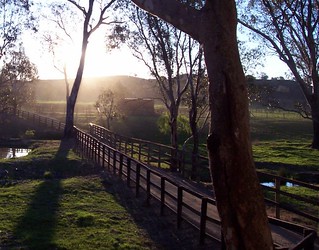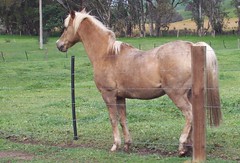During TAFE while planning a stud on an unlimited budget (I wish) for an assignment, as a class we were encouraged to consider fencing, what type we’d prefer but to also recognise for those studs on a budget what type of fencing is more likely to be used and the advantages/disadvantages of the different types.
 If on a budget, it had been pointed out to us that the class of horse should be considered. For example, for paddocks or yards that are inclined to house mares and foals, then perhaps a post and rail fence is the best choice (and if you want to go all out, why not Diamond Mesh?).
If on a budget, it had been pointed out to us that the class of horse should be considered. For example, for paddocks or yards that are inclined to house mares and foals, then perhaps a post and rail fence is the best choice (and if you want to go all out, why not Diamond Mesh?).
A boutique stud I worked on had all their paddocks decked out with post and rail and the yards were diamond mesh, considered a very safe form of fencing. The yards were where a lot of work was done with handling the foals and then later as weanlings.
For dry or barren mares, post and wire fences will be a cheaper alternative and these older, larger class of horses are less likely to get themselves caught up in a fence or end up going through.
Many a time on a couple of studs, my workmates and I have had to catch a foal and return it to it’s paddock and frantic mother. If bottom rails or wires are too high off the ground, it’s very easy for a foal to doze off on a fence line and wake up on the other side. Not a lot of fun if this fence line happens to have been poorly planned and the young horse ends up in a paddock full of barren mares who are very curious!
 Even if wire is your only possibility, you can improve the safety of this class of fencing by introducing a strand of sighter wire. It’s the white strand in the picture shown. This improves the visibility of the fence as wire fences are hard to see from a distance.
Even if wire is your only possibility, you can improve the safety of this class of fencing by introducing a strand of sighter wire. It’s the white strand in the picture shown. This improves the visibility of the fence as wire fences are hard to see from a distance.
Personally, I’d love to have post and rail across my dream 400 acres but will settle for post and wire, with a sighter wire as the middle strand and a top rail to improve visibility. Oh, and when I get my place I’ll want a maintenance man (or woman) who is very cluey about setting up fencing and where to get the best product for the best price!
 There are fencing companies out there that specifically cater for horses, providing an equine related job for those who are interested in producing this kind of product or designing one that is focused on safely restricting horses to a particular area. Many are moving away from wooden posts and wire, moving to synthetic products like polyethylene that are recognised as aesthetically pleasing as well as safer for horses.
There are fencing companies out there that specifically cater for horses, providing an equine related job for those who are interested in producing this kind of product or designing one that is focused on safely restricting horses to a particular area. Many are moving away from wooden posts and wire, moving to synthetic products like polyethylene that are recognised as aesthetically pleasing as well as safer for horses.
Take a look at:
– http://www.derbyfence.com/
– http://www.flexafence.com/
“Horse person’s glossary… Fence: Decorative structure built to provide your horse something to chew on.”
tag: horse stud, property design, maintenance, fencing

If one has a big budget and time, hedges with electric fence on both sides can form an attractive and useful landscape feature.
Two parallel fences around 10 feet apart can stop horses in different paddocks touching, avoiding that situation where one strikes out and gets a leg through a fence. One fence may be simply electric tape on posts, so long as the horses respect it.
A line of electric fence at the appropriate height also discourages horses from scratching their bottoms on the fence.